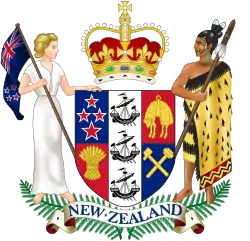Department of the Prime Minister and Cabinet (New Zealand)
The Department of the Prime Minister and Cabinet (DPMC) (Māori: Te Tari o te Pirimia me te Komiti Matua) is the central public service department of New Zealand charged with providing support and advice to the governor-general, the prime minister and members of the Cabinet of New Zealand. The department is also charged with centrally leading New Zealand's "national security planning, which includes civil defence."[2]
| Te Tari o te Pirimia me te Komiti Matua | |
 | |
| Agency overview | |
|---|---|
| Formed | 1990 |
| Jurisdiction | New Zealand |
| Headquarters | Level 8, Executive Wing, Parliament Buildings, Wellington WELLINGTON 6011 41.277899°S 174.776714°E |
| Annual budget | Vote Prime Minister and Cabinet Total budget for 2019/20 |
| Ministers responsible | |
| Agency executive |
|
| Website | www |
The department's overall area of responsibility is in helping to provide, at an administrative level, the "constitutional and institutional glue" within New Zealand's parliamentary democracy.[3]
The department along with the State Services Commission, and the Treasury constitute the central agencies or public service departments leading the state sector of New Zealand.[4]
Role
The department serves the Executive branch of government (the governor-general, the prime minister and the Cabinet) through the provision of impartial advice and support services.
In addition to serving the Executive, a major role of the department is to help co-ordinate the work of the core public service departments and ministries.
Supporting the prime minister and Cabinet
The department supports the prime minister's twin roles as leader of the government and chair of Cabinet, and provides three kinds of direct support to the prime minister:
- Support for constitutional issues, including those associated with the formation of governments; and issues associated with the operation of the Cabinet system.
- Overview of government activity and access to information on any and all issues that arise.
- Administrative support to the prime minister (and also to the governor-general). This includes services to the Prime Minister – such as preparing replies to Parliamentary questions, and dealing with Official Information Act 1982 requests and other correspondence.
Supporting the governor-general
The department also supports the governor-general of New Zealand in carrying out his or her functions to represent the Queen.
Structure
The department formally came into existence on 1 January 1990, as a result of a report which recommended establishing structures to provide two separate streams of advice to the prime minister; one, a new Government department to supply impartial advice and support to the prime minister and Cabinet (DPMC), and another, a Prime Minister's Private Office (which is not part of DPMC), to provide personal support and media services, and advice of a party political nature.
Government House was added to the department in August 1990. The National Assessments Bureau (formerly known as the External Assessments Bureau) became part of the department on 1 July 1991. Responsibility for civil defence and emergency management was consolidated in the department in 2014 through a business unit called the Ministry for Civil Defence and Emergency Management (MCDEM). MCDEM was superseded by an autonomous departmental agency hosted by DPMC in 2019, the National Emergency Management Agency (NEMA). Responsibility for leading the All-of-Government Response to the COVID-19 pandemic in New Zealand was transferred to DPMC from NEMA on 1 July 2020.
The department consists of eight business units.[5]
| Business unit | Role |
|---|---|
| Cabinet Office | A government secretariat that provides impartial support to central government decision-making processes and administers the New Zealand Royal Honours system. |
| COVID-19 All-of-Government Response Group | Coordinates, and where necessary leads, the All-of-Government response to the ongoing COVID-19 pandemic. |
| Government House | Provides administrative and support services for the Governor-General and maintains Government House and its grounds in Wellington, as well as the smaller Government House in Auckland. |
| Greater Christchurch Response Group | Provides policy, planning and monitoring support to Ministers on a broad range of regeneration issues across the greater Christchurch region. |
| Child Wellbeing and Poverty Reduction Group | Supports the Minister for Child Poverty Reduction and Minister for Children. |
| Policy Advisory Group | Provides advice and support to the Prime Minister in all Cabinet Committees and contributes to policy development across the full range of government issues. |
| National Security Group | Provides leadership, advice, support and coordination of the Government’s national security risks and priorities. |
| Strategy, Governance and Engagement Group | Supports DPMC to achieve its strategic priorities and manages risk by working across the department. |
Ministers
The department serves 4 portfolios and 3 ministers.
| Officeholder | Portfolio(s) | Other responsibilities) |
|---|---|---|
| Rt Hon Jacinda Ardern | Prime Minister Minister for National Security and Intelligence |
|
| Hon Grant Robertson | Deputy Prime Minister | |
| Hon Kiri Allan | Minister for Emergency Management |
Head of DPMC
Heads of the DPMC (formerly Secretary, now the Chief Executive) are:
| Name | Portrait | Term of office | ||
|---|---|---|---|---|
| 1 | David McDowell | 1990 | 1991 | |
| 2 | Simon Murdoch |  | 1991 | 1998 |
| 3 | Mark Prebble | .jpg.webp) | 1998 | 2004 |
| 4 | Maarten Wevers | .jpg.webp) | 2004 | 2012 |
| 5 | Andrew Kibblewhite | .jpg.webp) | 2012 | 2019 |
| 6 | Brook Barrington | .jpg.webp) | 2019 | Incumbent |
See also
References
- "Total Appropriations for Each Vote". Budget 2019. The Treasury. Retrieved 8 June 2019.
- "Department of the Prime Minister and Cabinet". Govt.nz. Retrieved 27 October 2017.
- "About DPMC". About DPMC. Retrieved 27 October 2017.
- "Archived copy". Archived from the original on 19 October 2014. Retrieved 18 October 2014.CS1 maint: archived copy as title (link)
- "DPMC's business units". DPMC's business units. Retrieved 3 August 2020.